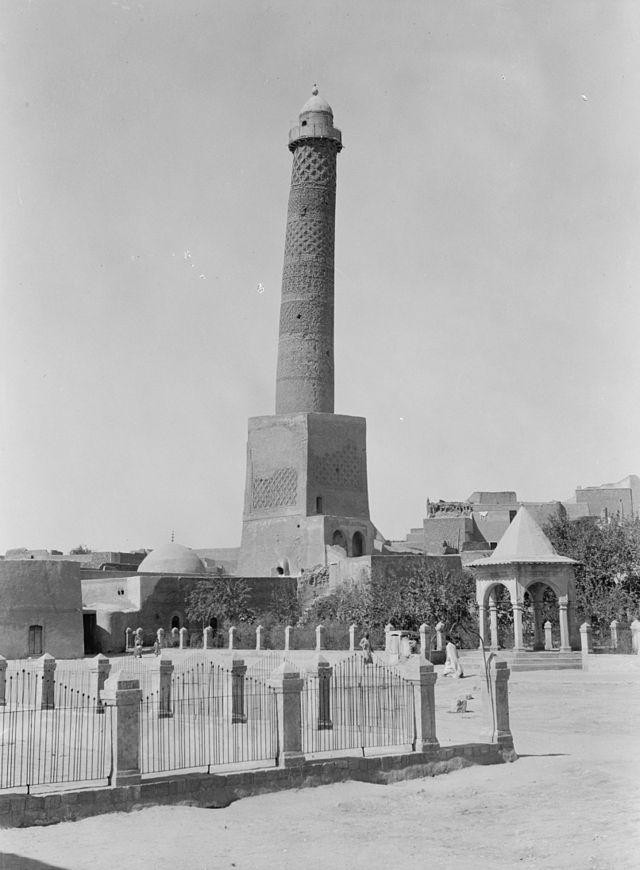ISIS’s destruction of the past, present and future in Mosul
By Thurayya Ibrahim*
With ISIS's destruction of the heritage of Mosul, it is no longer the “Pear of the North”. But it's people will rise up and reclaim their ancient city.

Part I: The ISIS disease in Mosul
Part II: Mosul's lost diversity
Wednesday 24 December 2014
In my previous article, I focused on the social and ethnic changes that have been forced on Mosul by the Islamic State (ISIS/ISIL), which will undoubtedly have long-term repercussions on the whole of Iraq and not just Mosul. ISIS has sought to radically reconstruct Mosul in every respect, razing, in the process, the previous social, political and economic structure.
The destruction of churches, mosques and other holy sites understandably received huge media attention internationally due to their symbolic importance. However, ISIS has also been systematically destroying much of Mosul's cultural heritage but this has not received the same amount of coverage.
Nineveh was the largest city in the world and the capital of the mighty Assyrian Empire under King Sennacherib (705-681BC). Its ruins are located near the banks of the Tigris, where it once blossomed as an important trading city between East and West. It is believed to have first been settled in 6000 BC. Various conquerors — Persians, Arabs, Turks and others — have come and gone, each leaving an imprint that remained for centuries until the day ISIS chose to launch their operation of “cultural and historical cleansing” in Mosul.
Major historical sites that stretch back millennia are being systematically wiped away. The determination to destroy the cultural and religious heritage is not enough for ISIS. There are also reports of looting of archaeological sites and the imposition of a “tax” on smugglers moving stolen artefacts. According to the head of the Baghdad Museum, Qais Hussein Rasheed, who was speaking at a UNESCO conference in Paris last September, the largest example of looting so far took place at grand palace of the Assyrian King Ashurnasirpal II which dates back to the 9th century BC. “Assyrian tablets were stolen and found in European cities,” he said. “Some of these items are cut up and sold piecemeal,” he added, in references to a tablet of a winged bull. ISIS took over Mosul's Monuments Museum which fell under their full control and has been shut to the public. Some locals have claimed that ISIS militants destroyed archaeological monuments at Mosul (Nineveh) Museum, including the famous winged Assyrian bull.
It is a frightful thought that such an ignorant and violent group are in charge of one of the world's richest archaeological treasures. With at least 8,000 years of continuous habitation, Mosul is considered a jewel that embraces many heritage sites belonging to numerous religions and sects, with almost 2,000 of Iraq's 12,000 registered archaeological sites being located there. In the first month of their invasion of Mosul, ISIS arrested the head of the Archaeology Department, Musa'ab Muhammed Jasim, for unknown reasons, though sources claim that he tried to defend the department from looting while some local residents have said that he was only detained for questioning and was released a few weeks later. These acts are clearly part of the same strategy of redefining Mosul's cultural identity whilst profiting from its rich heritage. How ironic it is that ISIS, which demolishes historical and archaeological sites and artefacts for being heretical and supposedly against Islam, have no qualms about profiting from them.
ISIS has a unit called Katayib Taswiya (the Demolition Battalion) whose job is to identify what they view as ‘heretical' mosques and sites for destruction. The battalion razes to the ground any mosques or churches built on tombs. If a graveyard has been built after the mosque's construction, then they will destroy the graves. Even this was not enough for ISIS. Graves that have headstones that are not level with the ground have all been bulldozed, and even the dead did not escape these atrocities. The demolition battalion unit drew up a list of sites and statues that were deemed unsuitable for an ‘Islamic state' and were to be destroyed. Among them were the much-loved statue of a figure representing an old Mosul profession: a man selling a liquorice drink, for which the city is famous. Until a few months ago, men walked the streets with a pouch of the drink slung over their shoulders and clanged copper goblets to advertise their presence, and sell the drink to people. This was soon stopped by ISIS as they forbade the practice of selling the drink, declaring the consumption of liquorice a sin. Naturally, the statue also had to go. The sculptor who made the statue in 1973, Talal Safawi, was distraught to see the liquorice seller statue, whom he regards as part of his body, destroyed. This statue had survived four decades during which there had been three wars, a US invasion and wide-scale looting, yet it finally succumbed to the brutality of ISIS.
Other statues destroyed by ISIS included Mullah Othman al-Musili, a beloved 19th-century musician and poet, and the famous statue of a woman carrying a urn. Another was Abu Tammam, the famous Abbasid-era Arab poet, born in Syria who then lived and died in Mosul in the year 845AD, who ironically was a Muslim convert born to Christian parents. Another important shrine which was levelled to the ground is the much-talked-about ‘Girl's Grave' or ‘Ibn al-Atheer's grave'. The ‘girl's grave' again is a very important feature of Mosul and for centuries it has been the subject of widespread speculation concerning the story behind it, as no one can be certain of the events that led to its creation. There are claims that the grave is that of the famous historian Ibn al-Atheer who died in Mosul in 630AD. However folktales say that centuries ago a pious girl in Mosul would go out caring for her goats and lambs, and one day she was surrounded by thieves and street bandits who wanted to rape her. After resisting their advances and calling out to God to take her and save her honour from being tarnished, the ground suddenly opened to swallow the girl as happy tears rolled down her face. People tried to pull her out but failed and she died instantly. The ‘girl's grave' became a symbol of God's miracle and the piety of Mosul's women. Perhaps ISIS did not want a monument that symbolised resistance, especially that of women. But no matter what they do or how far their brutality reaches, the people of Mosul will revolt and fight their tyrannical leaders.
The signs of resistance are slowly emerging. When ISIS indicated that it would be toppling the city's ancient leaning minaret, which is older than the Leaning Tower of Pisa in Italy and is pictured on Iraq's 10,000-dinar bank note, the people of Mosul were outraged. “The leaning minaret has no religious significance and is not a statue to be regarded as a heretical idol, so why are these foreign militants determined to wipe away Mosul's cultural identity?” asked a local medical student who cannot be named for his own safety. Residents gathered at the minaret and confronted ISIS, which has put a stop to the demolition of the minaret, at least for the time being.
Many have wondered why it took the people of Mosul so long to finally reject ISIS's orders and why they defended the Leaning Minaret yet failed to do so with all the other mosques and churches. It is puzzling but I think the speculative climate of swirling rumours that Mosul has been living under for the past four months prevents them from knowing what is fact and what is fiction. Furthermore, they never would have imagined that a group that calls itself “Islamic” would ever destroy places of worship.
The biggest shock to the people of Mosul which signified a turning point in their attitude was the day ISIS destroyed the Prophet Jonah mosque (Jonah's tomb). The imam of the mosque pleaded with ISIS to give him time to donate the rugs, fans and refrigerators to the poor people of the city rather than have blown up but he was met with firm refusal. Residents treading through the ruins of the building found torn and burnt pages of the holy books, which they had been unable to save, scattered amongst the rubble. “They claim that having graves inside mosques is heretical but what about the Quran, why did they not remove the Quran from the mosque before destroying it?” a local resident asked.
What international media failed to understand is that the Prophet Jonah mosque is of vast value to all the people of Mosul and not just Muslims. It is more than a mosque but a place visited by all sects and religions. A Christian man who had to flee Mosul was in tears when he heard that ISIS had demolished the mosque: “When my wife and I were trying for a baby and failed, we visited Prophet Jonah's tomb and prayed for a child. A few years later, we were granted a son. They have destroyed a place that gave me hope when I was at my lowest.” The mosque was a place that almost every resident of Mosul had visited or contributed to. It was like a grand house which gathered everyone, regardless of their differences. My own family had donated rugs to the mosque, as well as regular financial donations to help maintain it.
One of the names that are given to Mosul is ‘the city of the whale' in reference to the Prophet Jonah, whose tomb has now been destroyed. Other names given to Mosul are al-Faiha (“the Paradise”), but now it has become a hell on Earth, and al-Hadbah (“the Humped”) due to the leaning Minaret. It is also known al-Khaḍrah (“the Green”) in association with al-Khidr , a mystical figure (possibly St George) who is described in the Quran as a righteous servant of God possessing great wisdom or mystic knowledge and is believed to have been last seen in Mosul. It is sometimes described as “The Pearl of the North”, which helps explain why ISIS invaded the city in order to exploit its riches.
All these names are no longer indicative of the city's reality. Sadly, it seems that ISIS have succeeded in redefining Mosul to the loss of its inhabitants and the world.
Part I: The ISIS disease in Mosul
Part II: Mosul's lost diversity
____
*The author's name is a pseudonym.

